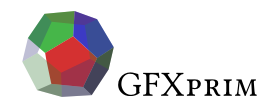import gfxprim.backends as backends # Create 100x100 X11 window bk = backends.BackendX11Init(None, x, y, w, h, "Window title", 0) # Assert that inicialization was successful assert(bk)

Python Backends module
The Python binding mostly maps to the C API with the GP_ prefix stripped.
Backend Initialization
Instead of having one unified initialization interface, each backend has it’s specific function and semantics. Still, once a backend is initialized, the backend structure provides a unified API for controlling the drawing.
There is however, a generic backend initialization function that takes a string as a parameter that may contain backend-specific settings.
BackendX11Init
Creates a X11 window. First parameter is display string, pass None for default display.
The x, y, w and h parameters describe the window geometry. The x and y are ignored by most of the window managers though.
The last parameter are bitflags. TODO: Export bitflags and add a list here.
This backends supports multiple windows. Each time you call the initialization routine new backend structure is returned. All backend instances share the Xlib connection so you need to wait or poll only on one of them. Each backend, on the other hand, has its own input queue.
|
|
See multiple windows example. |
BackendInit
from sys import stderr import gfxprim.backends as backends # This is a default init string backend_string = "X11:100x100" # Initialize backend by init string bk = backends.BackendInit(backend_string, "Window title") # Assert that inicialization was successful assert(bk)
Initialize the backend params by the backend_string. The last parameter is a file to print help or errors to.
|
|
See backend init example. |
Backend
Initialized backend has several members that allows you to draw on the screen and control the backend behavior.
import gfxprim.core as core import gfxprim.gfx as gfx import gfxprim.backends as backends # Initialize backend bk = backends.BackendInit("X11:100x100", "Window title") # Assert that inicialization was successful assert(bk) # Now you can draw into the backend via bk.pixmap bk.pixmap.gfx.Fill(bk.pixmap.RGBToPixel(0, 0, 0)); # If backend is buffered, changes are not propagated unless the screen is # updated via Flip() bk.Flip() # or UpdateRect() bk.UpdaterRect(x0, y0, x1, y1)
There are several functions to get input events such as keystrokes or pointer movements.
import gfxprim.core as core import gfxprim.input as input import gfxprim.backends as backends # Initialize backend bk = backends.BackendInit("X11:100x100", "Window title") # Assert that inicialization was successful assert(bk) # Now we can either poll for events via PollEvent() or wait via WaitEvent() while True: ev = WaitEvent(); if (ev.type == input.EV_KEY and ev.val.val == input.KEY_ESC): sys.exit(0) elif (ev.type == input.EV_SYS): if (ev.code == input.EV_SYS_QUIT): sys.exit(0) if (ev.code == input.EV_SYS_RESIZE): bk.ResizeAck() redraw(bk)
|
|
See the complete example. |